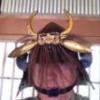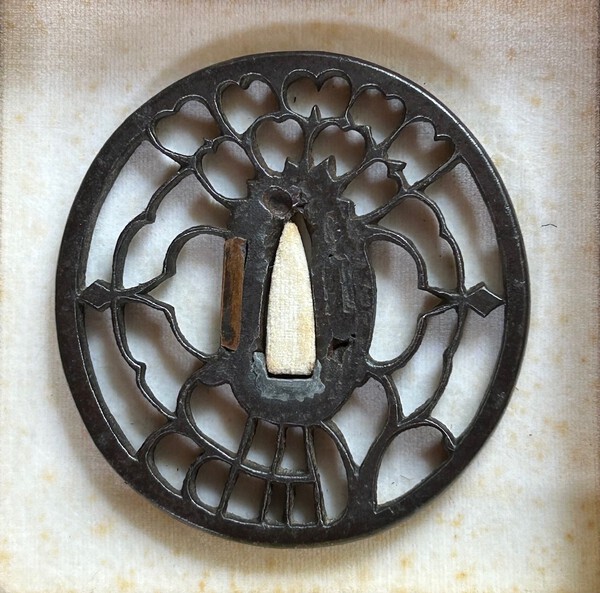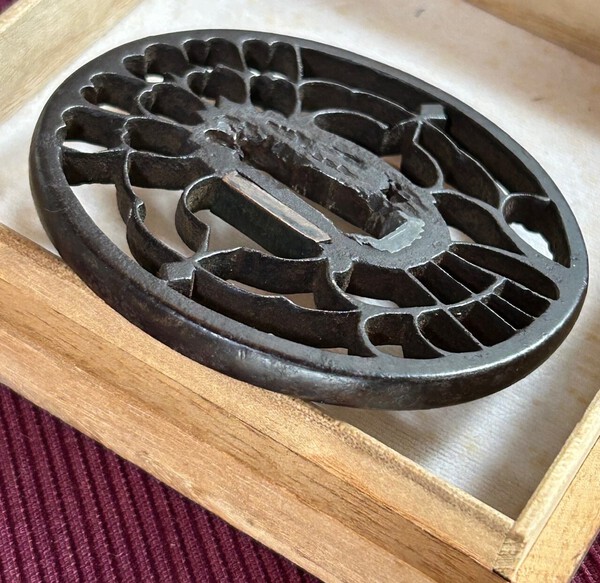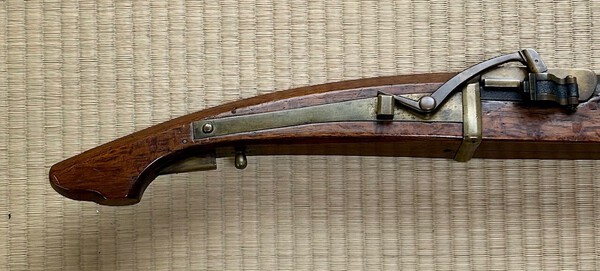-
Posts
13,681 -
Joined
-
Last visited
-
Days Won
246
Content Type
Profiles
Forums
Events
Store
Downloads
Gallery
Everything posted by Bugyotsuji
-
https://ja.wikipedia.org/wiki/木更津県 Well done on finding this gun. Many people are searching for a decent example but they are comparatively rare. For those marks on the side of the butt, look for very early temporary Prefectural names like 'Kisarazu Ken' which start with a Ki 木. National firearms roundups and registrations were held for all guns in Japan, starting with the big Jinshin roundup of 1872 in early Meiji. If it is a 'Jinshin Bango' you should be able to see some faint numbers there too. Registration stamps were placed either in the wood or sometimes on the upper part of the barrel.
-
The same egawa leather pattern was also used on cloth.
-
I have one English book of his, and two of his books in Japanese. Although it is full of errors (as you say) of one kind or another, not only editing, it still contains plenty of useful stuff. Also popular but sadly misinformed is Giving up the Gun by Noel Perrin. The best illustrated book in Japanese is Sawada Taira's Nihon no Furuju (Old guns of Japan), but it's out of print, and they can be difficult and expensive to source. Full of mostly accurate information. Worth getting a copy though for the abundance of photographs alone! Jan Pettersson and I have written a pretty comprehensive illustrated book on the Tanegashima, but we have not yet found a publisher to complete the work. We really need to get this into print!
-
Hi Brian, this is a date of June 1 Shohei 6 (Shohei 1346-70), but it is part of a well-known conventional design that you often find repeated on armo(u)r trimmings.
-
That sounds great Dale, having a working plan like that for retirement. (Are you left-handed?) Strangely enough, right after you started this thread, I immediately found myself in roughly the same position as you. I am now the proud owner of a signed Bizen long gun, in terrible condition and missing the serpentine and other bits. By the way, your 2nd generation Morishima gun is from Mashima, not too far from Bizen, actually; their guns have a good reputation. Your pan has been refurbished at least once, so it's had an active life. I am assuming you have already got the full reading... The first generation was working around Kaei (1848~), so your smith was active either in parallel or sometime after that.
-

Edo Period Corner Part II
Bugyotsuji replied to estcrh's topic in General Nihonto Related Discussion
Valuable words. Today I messed around with the Bizen barrel that someone gave me a year or two back, and the old Bizen stock I was given ten days ago. They are so close! Obviously the Mekugi holes do not line up (about a centimeter off, although the front one actually fits!) so I had to cut out two new channels inside the stock for the little iron loop-hole bridges under the barrel. The stock is all split lengthways so I held a partly-successful gluing session. Anyway, if you want to see what a hybrid, two-thirds of two small-bore Bizen long guns, looks like, here it is. Transformer! PS Another friend says he feels sorry that I have to give back the Inatomi-Ryu battlefield gun. He wonders if I would be interested in buying his extremely rare Hōkin (bronze) barrel long gun! So kind. I said “No, appreciate the thought”, etc., but… -
Re Piping. Red & white. Auspicious? Maybe this piping also incorporates the Japanese idea of harmonizing opposing sides, like the amalgamation of Shinto and Buddhism. It is said that the reversible red and white caps that elementary school children wear reflect the tradition of the Genpei wars, between the Taira/Hei and the Minamoto/Gen. A subtle statement of neutrality, of respect for both sides?
-

Edo Period Corner Part II
Bugyotsuji replied to estcrh's topic in General Nihonto Related Discussion
Resolution. No further action on this venerable old blade. A request for Togi would put a Togishi into making impossible choices. Although it could be tweaked, a Togishi might be tempted to give it the full works, but what would then emerge? Something very different? To summarize package update. Shirasaya created, received. Check. Tsunagi created, received. Check. Tantō blade tucked safely away for preservation. (*Shows typical Sō-Shū second-half of Namboku Chō workmanship. Around Eiwa.) Has accompanying Koshiraé and NBTHK paperwork. 長さ一尺O寸二分 反りわずか 重ね薄く、三つ棟板目肌に地景がからみ地沸つ く。表裏の刃文が違い、裏側は皆焼となる。”Length 1 Shaku 2 Bu, very slight sori, thin kasane, mitsumune, itame hada containing chikei, shows ji-nie. Blade front and back manifest contrasting hamon features, the back showing hitatsura.” (Quoting my sword appreciation sensei.) Photos available. -
Steve, a tsuba collector friend today said he sees the Akasaka possibility, but he gets a stronger sense of early Edo Kyoto, i.e. Kyo sukashi. The sukashi walls are not straight vertical cuts, but rather at an angle, which is for him a strong indicator for Kyoto. Also the mimi are not as rounded as you might expect for Akasaka.
-
Nice! Are you talking about the smallness of the blade itself or the whole thing? Either way, yes and yes. Yari came in all sizes. (Sadly though, many longer ones have have been cut down from their original length.)
-
Unbelievable triple coincidence. Just arrived at the museum in town to listen to a lecture on special order swords. Guess what the very first one I am looking at is… had no idea it was here!
-
Jussi, forgive the thread drift, but yes, it is a different naginata, but both were special order items, made for the same person, Miyake Ason, about 20 years apart! Funnily enough, I was round there again today, and doubly funny, there was an article in today's Sanyo Shimbun about the one you just mentioned above! I took a photo of the newspaper article about the Date naginata, and the NBTHK explanation of the tokubetsu juyo naginata owned by my friend. I will pm them to you. (All of my information above was correct except that it is not a Prefectural Bunkazai. That was a different blade.)
-
I read that late Akasaka tends towards thinner tsuba plates, but the three early generations made tsuba thicker at the mimi. Found this recently… Mimi seems quite thick. No immediately discernible tekkotsu.
-
https://ameblo.jp/toudou455/entry-12527870806.html This is a discussion of its possible functions. The writer has searched high and low but says he cannot find anything written as to the definitive use of ナマコ金 Namako-gane, other than that it was a feature of Ogino-Ryu (school of gunnery) guns, and later copied by others. The alternative word he notes is 力金 Riki/Chikara-gane, which could indicate a firmer grip obtained with your other fingers against it, in contrast to and to help the trigger finger aim safely and accurately. (He also repeats what I covered in my previous post.)
-
Dale, these are called Namako-gané, which is ‘sea-cucumber metal fitment’. There are several varieties of these. One I saw had a hollow (like yours?) that the trigger pulled back into. From what I understand they were a stopper, to protect the trigger when dropped or against accidental firing. They actually look good, I reckon, and do give a more comfortable grip for the other fingers. I have never been totally convinced though. I’ll check my sources once more!
-
“It’s the exception that proves the rule.” Perhaps that means the ‘rule of thumb’ rule.
-
Hmmm… could be a Tosa smith in Shikoku. The shape and construction of the butt should clarify this. Family name Ono. There are five Tanegashima matchlock gunsmiths listed under this name, two of them working in Tosa, a large province in the southern part of Shikoku. (There were two in Hyūga in Kyūshū, and one Ono smith in Bizen.) The style of your name is very similar to one of the listed Tosa smiths, so although unlisted I reckon yours should be a relative in the same Ono smith line. Can you spot it?
-
Congratulations on your purchase, Grahame! 大野善三郎作 Ōno Zenzaburō Saku (I think!) (Possibly Zensaburō?) I’m about to check this smith out. If I find anything I’ll post it here.
-

Any resources on the proper way to pack an armor into its box?
Bugyotsuji replied to fleetinbeing's topic in Katchu
All the pieces of an armour set were usually placed into individual soft cotton/hemp/linen bags, each with designation kanji on the outside. E.g. 脛宛 Sune-ate. But with all the materials available today we can protect things better. I remember Mr Morisaki once telling me that bubble-wrap is not good however, as it can trap moisture and can foster rust, etc. "Everything needs to breathe", he explained, while showing me some of that typical Jaanese wrapping paper. (He also disapproved of modern mothballs, and said that to protect against insect activity, dried togarashi peppers were usually placed inside an armour box.) -
Nothing to do with the subject matter but I was shown a naginata on Tuesday, the first time I have ever been tempted, a giant 'ryosaku' 両作, by Katsumitsu and Sadamitsu from Meio, around 1490, if my memory serves. In shirasaya, with no naga-e. Long nakago, with long special order Mei on one side and rows of Bonji on the other. The condition was ubu, and the blade was gorgeous, to my untrained eye. The owner said, "This is a Ken Bunkazai. Why don't you buy it?" I was a little astonished, as I was not there to buy anything and I only had four thousand yen in my wallet ($30), but it certainly was an attractive blade, and when I say tempted, I have never particularly wanted to own a naginata. "Just out of interest, how much are you wanting for it?" I asked politely. "Ten million JPY", he replied. Funnily enough, after that initial eye-watering, this dream blade haunts my memory.
-

Edo Period Corner Part II
Bugyotsuji replied to estcrh's topic in General Nihonto Related Discussion
Today the long-awaited phone call! The sun-nobi Masahiro tanto shirasaya and tsunagi are ready at last. He says that they have used a nice piece of ho-no-ki 朴の木 magnolia wood for a jewel-like surface finish. Hoping to pick them up at the sword museum on Sunday. All good thngs come to those who wait. The little pension is a blessing though, oil to the clanking gear wheels. Then the decision will have to be made on nugui, etc. "To polish, or not to polish" as my old friend Hamlet once said. -

Edo Period Corner Part II
Bugyotsuji replied to estcrh's topic in General Nihonto Related Discussion
Sometimes wish human relations could be simpler…











